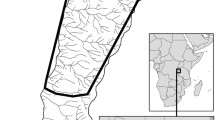Abstract
In 1973, personality ratings using a test called the Emotions Profile Index (EPI) were made on a number of Gombe chimpanzees, including a deviant female namedPassion. Passion's ratings were compared to the profiles of the other adult females from the same community.Passion's ratings were also analyzed in terms of her subsequent infanticidal and cannibalistic behavior, observed from 1975 to 1977. The EPI scales were found to be useful in detecting social deviance. The test appears to be a good descriptive and predictive measuring instrument. Suggestions are made for utilizing the EPI rating scales in the assessment of the psychological well-being of captive and/or research animals.
Similar content being viewed by others
References
Buirski, P., H. Kellerman, R. Plutchik, R. Weininger, &N. Buirski, 1973. A field study of emotions, dominance, and social behavior in a group of baboons (Papio anubis).Primates, 14: 67–78.
————,R. Plutchik, &H. Kellerman, 1978. Sex differences, dominance, and personality in the chimpanzee.Anim. Behav., 26: 123–129.
Driscoll, J. W. &P. Bateson, 1988. Animals in behavioural research.Anim. Behav., 36: 1569–1574.
Goodall, J., 1971.In the Shadow of Man. Houghton Mifflin, New York.
————, 1987.The Chimpanzees of Gombe: Patterns of Behavior. Belknap, Cambridge, Massachusetts.
Kellerman, H. &R. Plutchik, 1968. Emotion — trait interrelations and the measurement of personality.Psychol. Rep., 23: 1107–1114.
Martau, P. A., N. G. Caine, &D. K. Candland, 1985. Reliability of the Emotions Profile Index, primate form, withPapio hamadryas, Macaca fuscata, and twoSaimiri species.Primates, 26: 501–505.
Novak, M.A. &S. J. Suomi, 1988. Psychological well-being of primates in captivity.Amer. Psychol., 93: 765–773.
Plutchik, R., 1970. Emotions, evolution, and adaptive processes. In:Feelings and Emotions: The Loyola Symposium,M. Arnold (ed.), Academic Press, New York, pp. 1–24.
————, 1980.Emotion: A Psychoevolutionary Synthesis. Harper & Row, New York.
————, 1984. Emotions: A general psychoevolutionary theory. In:Approaches to Emotion,K. R. Scherer &P. Ekman (eds.), Lawrence Erlbaum Associates, Hillsdale, New Jersey, pp. 197–219.
————, 1989. Measuring emotions and their derivatives. In:The Measurement of Emotions,R. Plutchik &H. Kellerman (eds.), Academic Press, New York, pp. 1–35.
———— &H. Kellerman, 1974.Manual for the Emotions Profile Index. Western Psychological Services, Los Angeles.
Author information
Authors and Affiliations
About this article
Cite this article
Buirski, P., Plutchik, R. Measurement of deviant behavior in a gombe chimpanzee: Relation to later behavior. Primates 32, 207–211 (1991). https://doi.org/10.1007/BF02381177
Received:
Accepted:
Issue Date:
DOI: https://doi.org/10.1007/BF02381177




